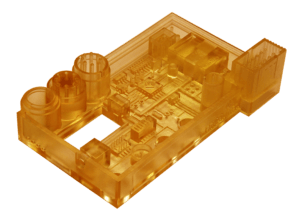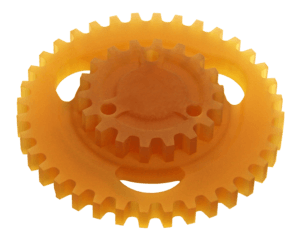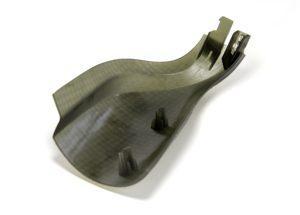
2017 is a big year for EnvisionTEC, which celebrates its 15th anniversary with the release of several new products. The 3D printer manufacturer has always been a prolific one, with its printers now numbering at over 40, and it isn’t slowing down this year. This week is the RAPID + TCT show, a venue that traditionally sees multiple new product unveilings, and EnvisionTEC will be bringing several new products to the show floor, including an updated 3D printer and several new materials.
 The Perfactory 3D printer was EnvisionTEC’s first product offering 15 years ago, and it’s stood the test of time, now in its fourth generation. Introduced in 2002, it was the first DLP 3D printer to hit the market. DLP is similar to SLA, except it’s faster and more accurate thanks to EnvisionTEC founder and CEO Al Siblani’s idea to use a high-definition theatre-style projector system to expose one cross section of the printing material at a time for rapid curing. DLP 3D printing also has the ability to cure each voxel to a different depth, resulting in greater resolution and surface quality.
The Perfactory 3D printer was EnvisionTEC’s first product offering 15 years ago, and it’s stood the test of time, now in its fourth generation. Introduced in 2002, it was the first DLP 3D printer to hit the market. DLP is similar to SLA, except it’s faster and more accurate thanks to EnvisionTEC founder and CEO Al Siblani’s idea to use a high-definition theatre-style projector system to expose one cross section of the printing material at a time for rapid curing. DLP 3D printing also has the ability to cure each voxel to a different depth, resulting in greater resolution and surface quality.
It only seems fitting that the Perfactory 4 (P4) should be in the spotlight at RAPID, bearing a brand new update: a custom LED light system that has been in development for more than a year. The light system, which will be implemented across the entire P4 line, is more powerful and efficient than other projector light systems on the market, according to EnvisionTEC.
“EnvisionTEC’s new LED system is an example of how we listen to our customers and have worked with them for 15 years to develop better 3D printing solutions,” said Siblani. “Our new LED system will offer production 3D printer users much lower operating costs. As an added benefit, the exceptional detail that our machines already produce will get even better because of the improved range of brightness from the LEDs.”
 The P4 LED Standard XL, which will be unveiled at RAPID, has a build envelope of 192 x 120 x 180 or 230 mm, with an XY accuracy of 100 μm, while the P4 LED Mini offers a resolution as low as 10 μm, with an adjustable Z resolution ranging from 15 to 150 µm. The cost savings from the new LED light system are significant: the average cost of the P4’s outgoing ultra-high-performance lamp, which uses high-pressure mercury gas, was $2.90 per hour, with an estimated lifespan of 500 hours, while the cost of the new LED light system is $.50 per hour with an estimated life of 10,000 hours.
The P4 LED Standard XL, which will be unveiled at RAPID, has a build envelope of 192 x 120 x 180 or 230 mm, with an XY accuracy of 100 μm, while the P4 LED Mini offers a resolution as low as 10 μm, with an adjustable Z resolution ranging from 15 to 150 µm. The cost savings from the new LED light system are significant: the average cost of the P4’s outgoing ultra-high-performance lamp, which uses high-pressure mercury gas, was $2.90 per hour, with an estimated lifespan of 500 hours, while the cost of the new LED light system is $.50 per hour with an estimated life of 10,000 hours.
In addition to the newly updated P4 series, EnvisionTEC is also introducing seven new materials at RAPID, three new engineering-grade materials and four new medical materials.
That includes EnvisionTEC’s first-ever line of medical-grade materials for its 3D-Bioplotter series of bioprinters. These include:
 Silicone TG, a technical-grade silicone for building soft implant surgical models such as noses and breasts. The material features low shrinkage, medium hardness of about 20 Shore and no smell. It requires curing and is ideal, according to EnvisionTEC, for larger parts.
Silicone TG, a technical-grade silicone for building soft implant surgical models such as noses and breasts. The material features low shrinkage, medium hardness of about 20 Shore and no smell. It requires curing and is ideal, according to EnvisionTEC, for larger parts.- PCL 45K RG, a research-grade (RG) polycaprolactone (PC) for tissue engineering applications. The material’s surface erosion allows for the controlled release of additives during its one- to three-year degradation period, meaning that it’s well-suited for drug delivery and bone and cartilage regeneration.
- LT Support RG, a low-temperature research-grade saccharide derived from cellulose. The biocompatible, cell-friendly material can be processed as a hydrogel and dissolved in distilled water, making it a good support material. Its processing temperature is 23ºC.
- HT Support RG, a high-temperature research-grade material derived from sugar. It is also designed as a support material that dissolves in distilled water. Its processing temperature is 150ºC.
A few new materials will be joining EnvisionTEC’s Engineering-Grade line, as well. Available for the company’s Desktop, 3SP and Perfactory 3D printers, these materials include:
- E-CE, a stiff material with high heat and chemical resistance. With a heat deflection temperature of 170ºC, E-CE is comparable to other cyan-type ester materials and is well-suited to industrial applications that require thermal stability, like electronics encasements and under-the-hood parts.
- E-Poxy, a tough, dual-cure material that is partially biosourced. It delivers strong, thin-walled final parts with a good balance between flexibility, hardness and heat resistance and is ideal for connectors.
- E-Model Flex, a highly accurate modeling material with improved elongation at break. It will be offered in a light and dark color.
- E-Poxy
- E-CE
- E-Model Flex
“These new offerings showcase our commitment to material development as well as our close relationships with customers, who have asked us to develop specific materials for our highly accurate and reliable machines,” said Siblani.
EnvisionTEC will be showcasing parts 3D printed from the new materials, as well as the updated LED P4 3D printer line and a lot more at RAPID. Come visit them at Booth #1813. Discuss in the EnvisionTEC forum at 3DPB.com.
Subscribe to Our Email Newsletter
Stay up-to-date on all the latest news from the 3D printing industry and receive information and offers from third party vendors.
You May Also Like
IperionX Inks 10-Year Deal with Wisconsin Manufacturer for 80 Metric Tons of Titanium Per Year
IperionX, the Charlotte-based supplier of sustainable titanium powders used for additive manufacturing (AM) and metal injection molding (MIM), has signed a ten-year deal with United Stars, a group of industrial...
Gastronology Launches Industrial Production of 3D Printed Food for Dysphagia Patients
Food 3D printing has, in many ways, been an additive manufacturing (AM) segment looking for the right business case. While some applications are beautiful and others may or may not...
Lockheed Martin Leads $3M Investment in Q5D’s Electronics 3D Printing System
Q5D, an original equipment manufacturer (OEM) of robotic arm, hybrid additive manufacturing (AM) systems used for wire harness production, has closed a $3 million investment round. The investment arm of...
3D Printing News Briefs, April 6, 2024: Depowdering, Cybertruck Door Handles, & More
In today’s 3D Printing News Briefs, ioTech’s digital manufacturing CLAD technology is opening up opportunities for microelectronics and additive manufacturing. Hexagon and Raytheon Technologies commercially released the Simufact Additive Process...


































